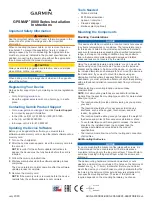
121
Humminbird® products have a Noise Filter menu setting that allows the user to
clear the screen of noise that is difficult to eliminate.
Pixels:
Pixels are the “picture elements“, or small square blocks, that make
up the image on the LCD. Measured as a vertical by horizontal number
(i.e. 640V x 320H), this key specification typically indicates the quality of
resolution. In fishfinders, the total resolution (vertical multiplied by horizontal)
is often less important than the “Vertical Pixel“ resolution. See
Pixels, Vertical
.
Pixels, Vertical:
Vertical Pixels are a number of vertical picture elements in a
single column on an LCD display. A greater number of vertical pixels provide finer
resolution of targets detected by sonar. Essentially, a vertical distance (the depth),
when divided by a larger number, breaks that distance into smaller samples, each
representing a smaller area and thus providing more detail. In fishfinders, vertical
pixels are more critical than horizontal pixels because the horizontal axis of the
display represents time, or history. Sonar information on the horizontal axis can
vary greatly, depending on boat speed and the Chart Speed setting. A greater
number of horizontal pixels show more sonar history that the boat has passed
through. On many models, Humminbird® provides the most vertical pixels to
provide a better display resolution. See
Chart Speed
and
Pixels
.
Power Output:
Power output is the amount of sound energy emitted into the
water by the sonar transmitter. Power output is measured using either RMS (Root
Mean Square) or P-T-P (Peak-to-Peak) measurement systems. Either method is
acceptable, but it is important, when comparing power outputs, to make sure that
the same measurement system is being used for both outputs, because P-T-P
numbers are 8 times higher than RMS numbers. Greater power output allows the
sonar signal to penetrate through weeds and thermoclines, reach deeper depths
and operate more effectively in noisy environments, such as when the boat is
running at high speed.
Pulse Width (Pulse Length):
Pulse Width is the length of time that a sonar sound
burst is transmitted into the water. Shorter pulse widths provide better target
separation, but cannot travel to great depths. Longer pulse widths provide better
depth penetration, but result in poorer target separation. Humminbird® varies
pulse width based on depth to optimize both target separation and depth
performance. See
Target Separation
.
Glossary
Содержание 587ci Combo
Страница 10: ......
Страница 58: ...48 Simulator Start Up Options Menu ...
Страница 66: ...56 Sonar Tab Normal Mode Sonar Tab Advanced Mode Main Menu ...































